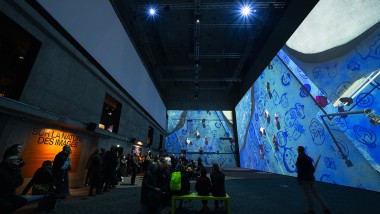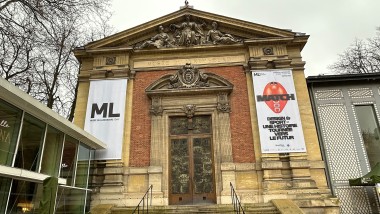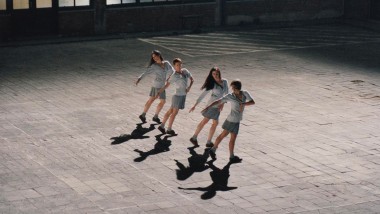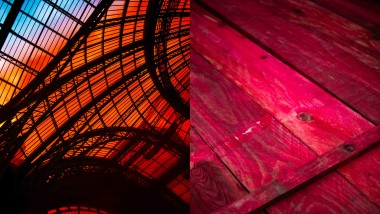
The Fontainebleau School
Fontainebleau: the centre of an Italian school in France
An artistic revolution occurred in France during the first half of the 16th century.
Europe opened up. As a result of the Italian wars (1494-1547), the French aristocracy became familiar with the Italian Renaissance. At the same time, the discovery of America had a profound impact in Western consciousness. The English and Dutch controlled trade with the Indies.
Art in Europe developed across frontiers. Italian artists, including Leonardo da Vinci, were called to court to work for an elegant princely society: mural painting, sculpture, stained glass, tapestry, gold and silver work, decoration from monuments, enamels and short-lived decoration projects for feasts.
The term "Fontainebleau School" refers to an artistic trend brought about by Italian artists commissioned by Francis I in 1530 to decorate his residence at Fontainebleau. The rise of the School continued into the reign of Henri IV.
However, the expression was first used in the 19th century. The term refers to artistic production within the setting of the Fontainebleau château and extends to a style which would soon spread throughout Europe.
Ecouen château, which today houses the Renaissance museum, testifies to the influence of the Fontainebleau School. It represents the key emergence in France of the "second" Renaissance after 1527 (date of the sacking of Rome by Charles V’s forces).
The first Fontainebleau School
The first expression of this movement flourished between 1530 and 1570, spanning four successive reigns: Francis I (1515-1547), Henri II (1547-1559), Francis II (1559-1560) and Charles IX (1560-1574).
The style is characterized by Italianism, the taste for abundant and refined ornamentation, symbolic references and recurrent themes, as well as a sensuality – new to France – in the representation of the body.
Female figures haunt the vaulted ceilings, walls and arches of Fontainebleau. Through mythological figures intended to magnify power, the artist represents the reality of his time. The inspiration from Antiquity encourages decorative excess. The use of Medieval imagery also plays a fundamental role in assimilating the Italian Renaissance into the French mentality.
The School combined freshness of colours, decorative taste, elongation of shapes, the grace of the nudes, and a harmonious balance in the composition. The trompe l’œil technique was used deliberately here. The famous portrait of Gabrielle d’Estrées in the Louvre Museum presents two figures painted with sensuality and in an identical way. The trompe-l’oeil affect is again accentuated by the presence of a second theme, taking place in the background of the first.
Fontainebleau château, the "house of the centuries, true home of kings" – as Napoleon I would subsequently call it – became the centre of the Italian School in France. When Francis I returned to his kingdom in 1527 from captivity in Madrid, he moved permanently to Fontainebleau, where he enjoyed the pleasures of hunting in the forest rich in game which surrounded what was just an “old mansion”.
Francis I decided to modify and rebuild the Medieval château to make it a royal residence: the entire building was reconstructed apart from Saint Louis’s keep. The project was vast. Vasari declared that Fontainebleau had become almost “a new Rome”. To decorate the interiors, the king called on Italian decorators and artists: Giovanni Battista di Iacopo known as Rosso Fiorentino (“the Red Florentine”) and Francesco Primaticcio, known as Le Primatice.
Italian painters in France
Rosso, a Florentine artist trained in the studio of Andrea Del Sarto and influenced by Michelangelo, became Francis I’s official painter. The king invited him to France in 1531 to oversee the decoration of the château at Fontainebleau. The artist also produced designed for clothes, gold and silver work and a great staircase in the Classical style in the oval courtyard. The most famous example of his work at the French court is the decoration of the Francis I gallery which he designed between 1533 and 1539: the frescoes are framed by large stucco figures in haut relief.
The iconography of this key work to the glory of the king was inspired by Classical mythology and history. It had a considerable influence on all decorative arts.
Le Primatice, a Bolognese artist trained by Giulio Romano during construction of the Palazzo Te in Italy, joined Rosso in France in 1532.
Following the death of Rosso in 1540, Le Primatice took over decoration works on the château. Nicolo dell’Abate, established in Bologna, was also called to Fontainebleau by Henri II in 1552. He became Le Primatice’s assistant and collaborated with him on the decoration of the château, particularly for the decor of the ball room and the Ulysses gallery (vaulted ceiling decorated with scenes from Antiquity, the life of Ulysses, the grotesques etc.).
Around these masters a team of specialists in frescoes, stucco and carpentry formed to work on the decoration and furnishing of the château: most notably the Italian Luca Penni, a pupil of Raphael, Léonard Thirty from Flanders, and the Frenchmen Charles Dorigny and Antoine Caron.
Engravings by the Fontainebleau School
Le Primatice also played a key role in the creation of an engraving studio using etching solution in around 1542-1543. This technique involves tracing a composition using a point into a lacquered copper plate, before allowing it to be eaten away by the corrosive action of the acid. In the 1540s, artists from the Fontainebleau School produced engravings from the château’s frescoes and drawings. For this court art they sometimes chose religious, mythological or allegorical subjects.
These included: Antonio Fantuzzi, a Bolognese painter of grotesques in Fontainebleau from 1537 to 1550, who engraved more than 100 etchings between 1542 and 1545; Léon Davent who adapted Le Primatice in his work; and Jean Mignon who engraved around 60 etchings between 1543 and 1547, including erotic works. Other artists practised engraving as an original work, notably Geoffroy Dumoustier, who assisted Rosso in Fontainebleau from 1537 to 1540.
From 1545, a new centre for engraving developed in Paris, returning to the themes of the Fontainebleau artists, and further spreading the philosophy and style of the Fontainebleau School.
The privileged place of tapestry
Tapestry is one of the key art forms to emerge from Fontainebleau. It held a privileged and especially opulent place in the decoration of royal and princely residences. Silks were decorated with gold and silver thread. The fabrics were imported from Flanders, but many weavers also worked in France. Francis I even established a tapestry workshop at the château in around 1540.
Stained glass
Italianism flourished in France in the 1530s and became truly established in 1540 with the success of the Fontainebleau School. Parisian stained glass artists used the Fontainebleau style in Gisors in Normandy, where the grisaille of the Life of the Virgin (1545) is considered as an example of stained glass comparable to the art of Fontainebleau. The Story of Psyche panels in the galleries at Ecouen, also represent exceptional examples.
Sculpture
The arrival of Italian artists in Fontainebleau left its mark on French sculpture. The presence of Michelangelo’s two slaves (1550) on the façade of Ecouen would have a significant influence on his contemporaries.
The famous Italian goldsmith Benvenutto Cellini who stayed at Fontainebleau (1537; 1540-1545), produced a prestigious semi-circular bronze relief representing the Nymph of Fontainebleau at the request of Francis I. This work, which decorated the tympanum of the Golden Gate, was very influential. It echoed the iconography of a fresco placed at the centre of the Francis I gallery painted by Le Rosso representing the legend which gives Fontainebleau its name. Meanwhile, Jean Goujon, the most important French sculptor of the period, drew inspiration from the art of Le Rosso and Le Primatice and lessons from Italians in general.
The second Fontainebleau School
This refers to the period of painting from the reign of Henri IV: Toussaint Dubreuil, Martin Fréminet and Ambroise Dubois, known as Bosschaert (1567-1619) a French painter from Anvers. These artists decorated royal residences, in Fontainebleau, the new château of Saint-Germain-en-Laye, the Louvre and the Tuileries.
The painter Toussaint Dubreuil trained in Fontainebleau under Ruggieri with whom he collaborated on the Story of Hercules in the Pavillon des Poêles. Martin Fréminet received his first training in his father’s studio at the same time as Toussaint Dubreuil, who he replaced in 1602 as the king’s painter. Henri IV commissioned him to decorate the Chapelle de la Trinité. The vaulted ceilings theme recounts the story of the redemption of Man, from the Flood to Gospels. Ambroise Dubois meanwhile received important commissions for decorative series for the château at Fontainebleau from 1600. He was appointed painter to the queen, Marie de Médicis, in 1606. His style demonstrates the linear grace of Le Primatice and the Mannerism of Spranger. He decorated the queen’s apartments with eight scenes from the story of Clorinda (six survive), and the Diana Gallery with mythical subjects and the life of Henri IV. He also decorated the king’s apartments (now the Louis XIII drawing room – story of Charicles and Chariclea).
The Fontainebleau School spread throughout France and was emulated in other European courts of the time. It played a considerable role in the blossoming of the Renaissance in France. The grace of the works it produced enchanted the court of Francis I, reflecting a new conquest, that of the body, and their symbolism increased their mystery.
Fontainebleau then became very famous for its château, the status of which increased from a royal estate to that of a real royal residence, entirely rebuilt by Francis I, who decorated it considerably by importing Italy, its art and its artists. He made it the headquarters of the French Renaissance, of which he wished to be the prince. Guides recommended artists from the 16th to the 19th century to visit Fontainebleau, a "royal home, formerly inhabited by Saint Louis, and more recently by Francis I”.


Design goes the extra mile for sport! The trailer for the next exhibition at the Musée du Luxembourg
Article - 11 March 2024
‘Rosas Danst Rosas', A contemporary dance by Anne Teresa De Keersmaeker in response to Stein
Article - 24 January 2024

